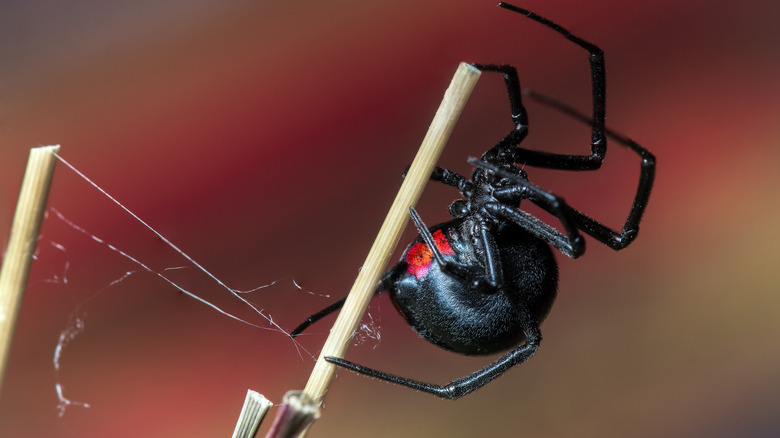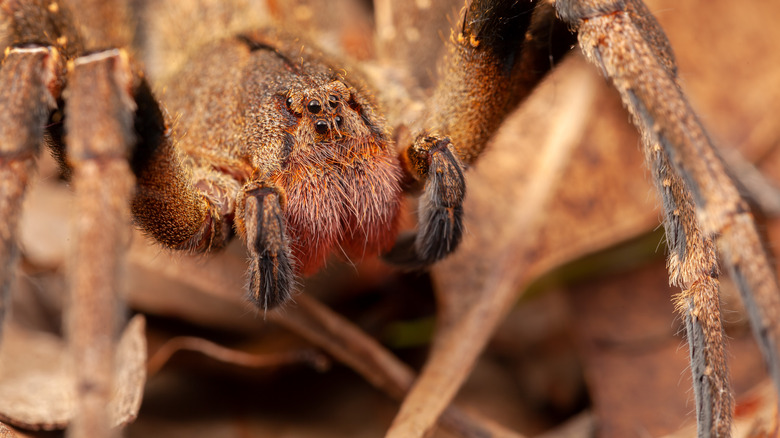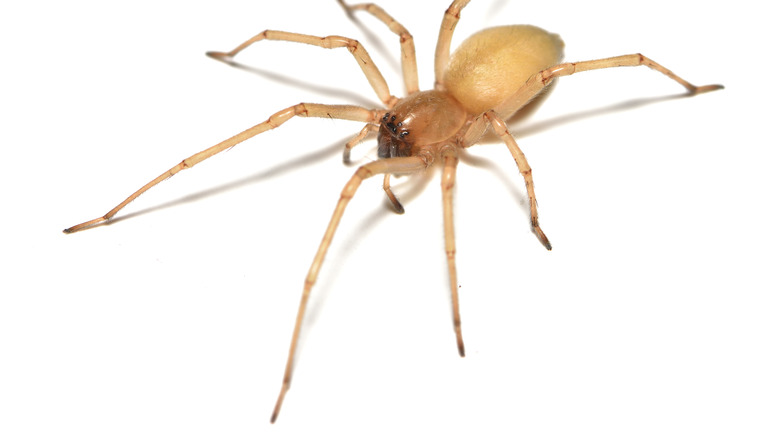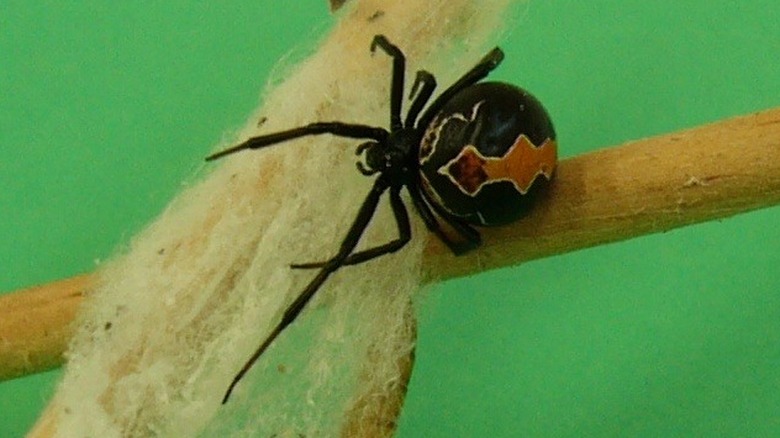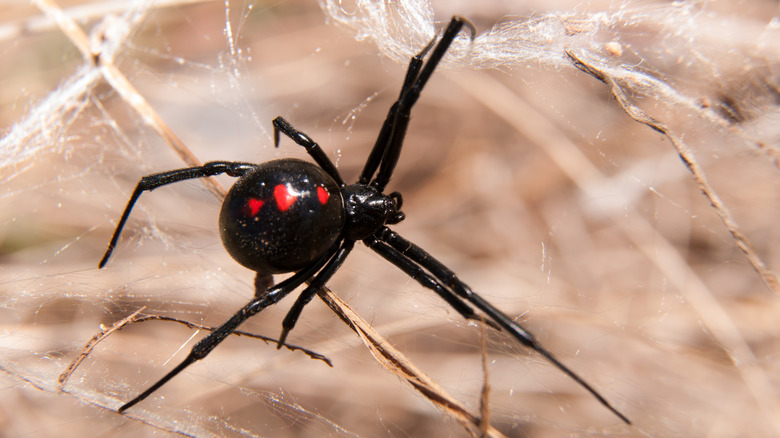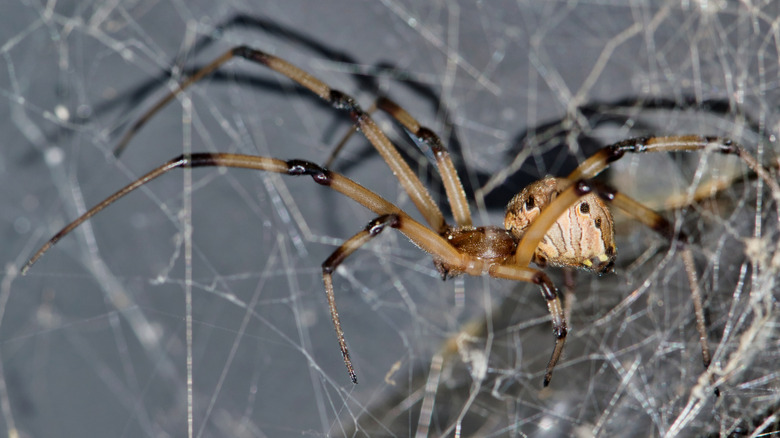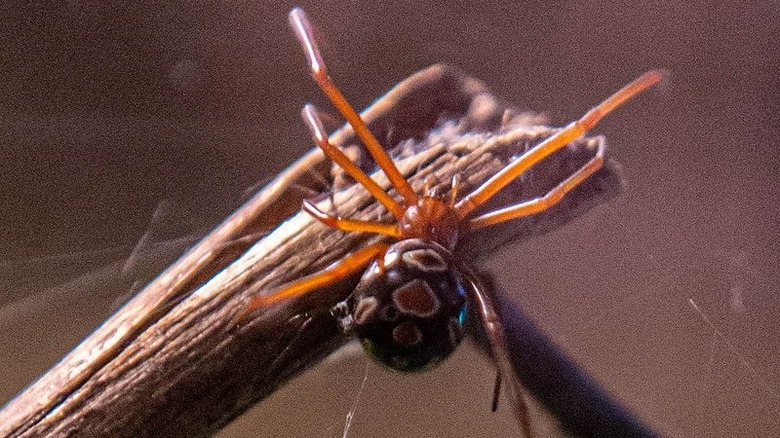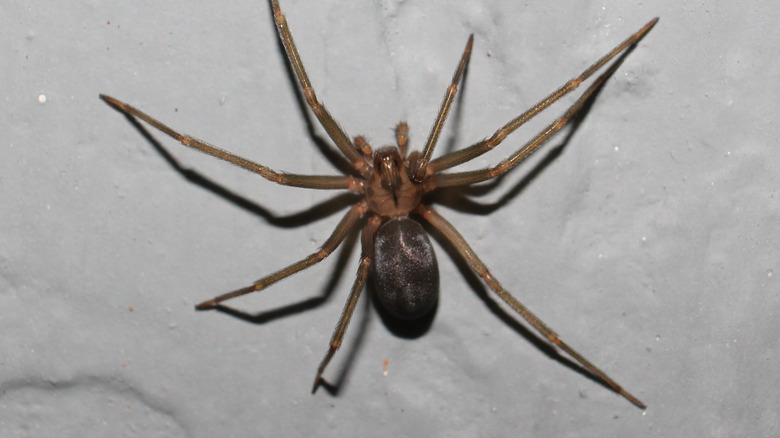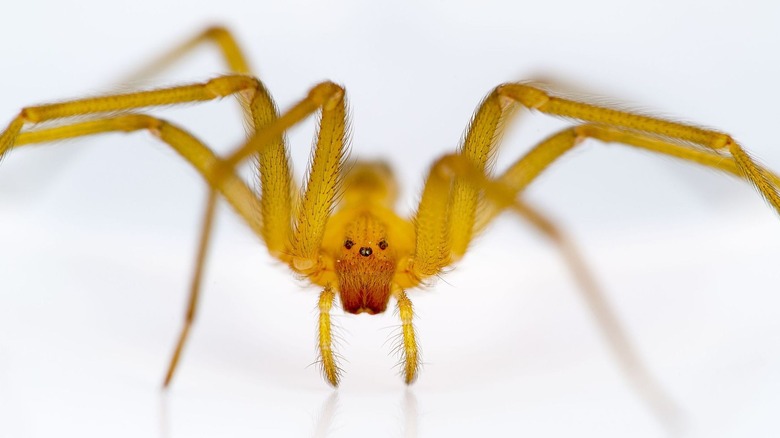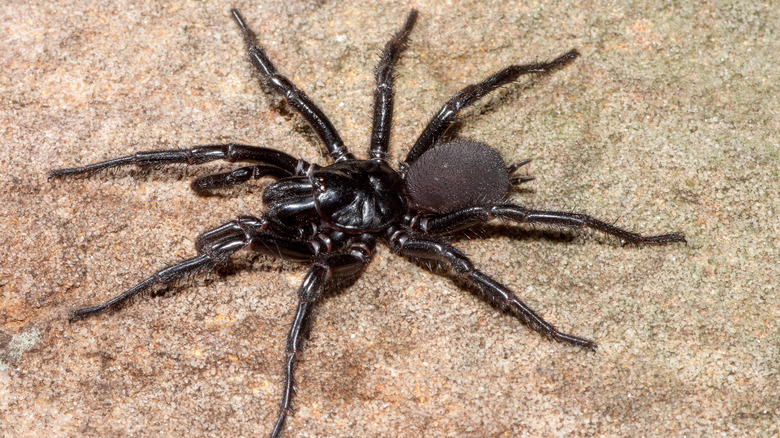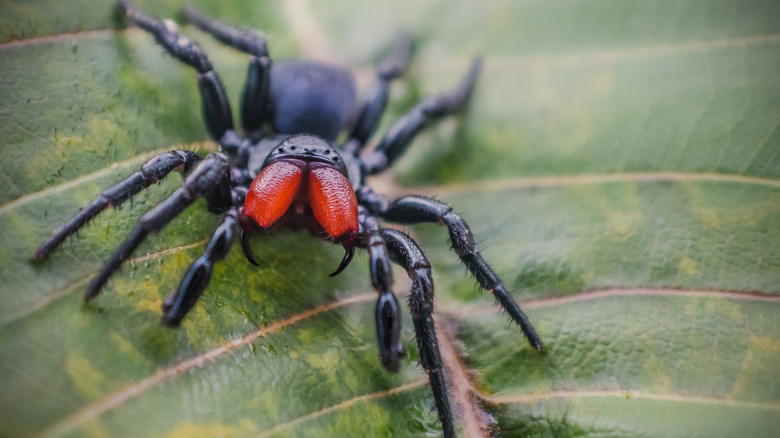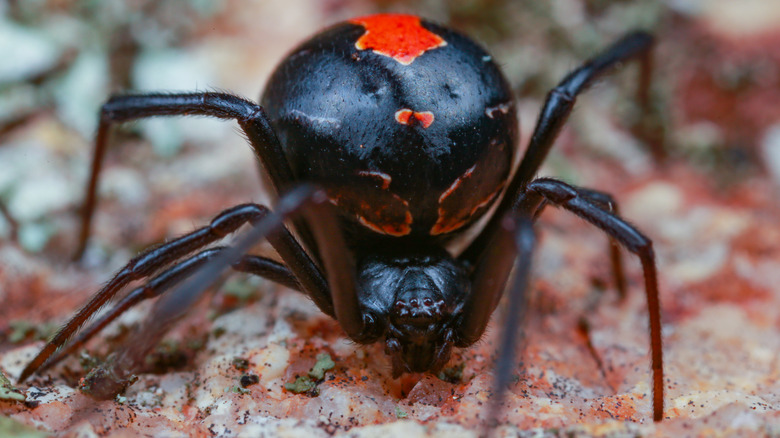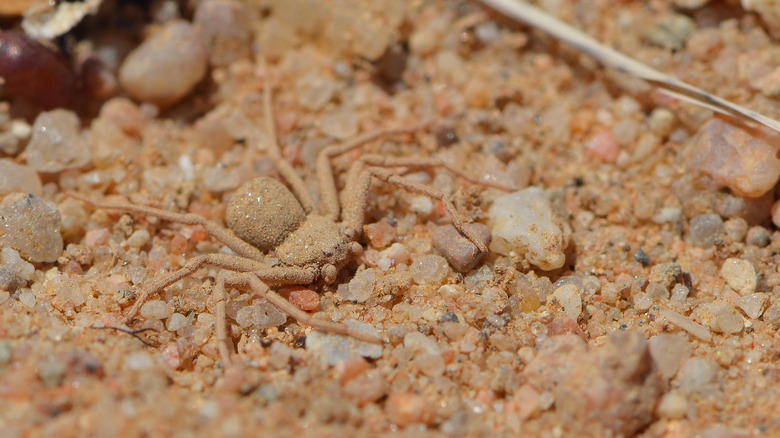The Most Dangerous Spiders In The World
A world without spiders may sound spectacular to an arachnophobic, but it would actually be an ecological nightmare. From their appetite for crop-consuming insects to the potentially life-saving compounds in their venom, these amazing arachnids actually make the world a friendlier neighborhood.
That's not to say, however, that it's completely nonsensical for humans to fear the 45,000-plus known species of spiders in the world (via National Geographic). A 2017 study suggested that arachnophobia may have been an evolutionary response to keep humanity on its toes when it comes to spiders. Considering how certain species of lethal spiders may have been more common during our evolutionary history, this does make sense.
In reality, spiders rarely bite and are just as eager to avoid you as you are them. Furthermore, antivenom now exists for various types of spider venom. Still, that's no reason to tempt fate and mess around with spiders — especially any of the following species, which all prove the wisdom behind the old adage, "An ounce of prevention is worth a pound of cure."
Brazilian wandering spider
You're at home, and you feel your stomach grumble. Luckily, a fresh bunch of bananas is sitting on the kitchen counter. You reach for one, and just as you're about to unpeel your snack, you notice some spider eggs stuck to it. Shocked, you immediately call pest control. After inspecting the bunch, they tell you something that really makes you go bananas — that unpleasant surprise came from an incredibly toxic spider species whose genus name, in Greek, means "murderess" (via LiveScience). That's exactly what happened in 2014, reported The Guardian, when a woman from Essex, England, discovered eggs attributed to the extremely venomous Brazilian wandering spider in her groceries.
These hairy, predominantly brown spiders from Brazil don't build webs. Rather, these nocturnal wanderers scour forest floors, attacking their prey with what has been called the "most neurologically active venom of any spider," according to The Guardian. Described by LiveScience as "a complex cocktail of toxins, proteins and peptides," one bite can cause a range of symptoms — including irregular heartbeat, hypertension, nausea, vertigo, hypothermia, and convulsions — within half an hour. If left untreated, it can kill a human being.
Fortunately, these spiders hardly bite humans, and when they do, they rarely inject enough venom to kill a person. In fact, entomologist Richard Vetter told LiveScience that because they rarely leave Brazil, other countries' exterminators are often unfamiliar with them, leading to many cases of pest controllers mistakenly identifying relatively harmless spiders as Brazilian wandering spiders.
Yellow sac spider
In 1957, W. C. Reeves was jolted awake at 3:45 a.m. by a "sharp, penetrating pain" under his right eye. He quickly discovered the source of his pain — a pale-yellow spider less than half an inch long. He soon experienced throbbing pain from his cheek to his jaw, an ordeal that lasted nearly 12 hours. A doctor from the American Museum of Natural History identified it as a juvenile Cheiracanthium spider, wrote Reeves and his colleague D. P. Furman in their paper. The authors found 14 of these so-called yellow sac spiders in Reeves' residence in North America.
There's no doubt that a yellow sac spider bite can cause immense pain, in the form of inflammation, headaches, or nausea. What many seem to disagree on is if its venom really causes the death of body tissue (necrosis). A 2006 paper provided evidence to the contrary — researchers examined 20 confirmed yellow sac spider bites and found that none of them resulted in necrosis.
While their venom doesn't seem to be particularly lethal, there are other ways yellow sac spiders may bring about dangerous situations. BBC reported that in 2014, major car manufacturer Mazda issued a voluntary recall notice on certain models, after reports that the smell of petroleum emanating from the cars kept attracting these spiders. The yellow sac spiders would take up residence inside the vehicles' canister vents, resulting in pressure buildup, blockages, and a massive fire risk.
Katipō spider
According to New Zealand's Ministry of Health, only three out of the 2,500 spiders in the country pose any sort of real danger to humans, only two of them are particularly venomous, and only one is a native — and sadly, dwindling — species. Of course, with a name that means "night-stinger," it's no wonder that the katipō spider's legendary reputation as a small-sized heavy hitter has not been affected by its rapidly declining population (via Australian Geographic).
The law prohibits anyone from capturing or intentionally killing a katipō spider, and rightly so. Experts estimate that only a few thousand katipō spiders live along the shores of the North and South islands. Interestingly, these infamous arachnids prefer to avoid humans, taking up residence in empty bottles, driftwood, discarded cans, and other trash scattered along the sands. In other words, you'd really have to go out of your way to find — or get bitten by — one.
The bigger, more fearsome-looking females of the species are the ones confirmed to be capable of delivering toxic bites. And when they do, they can inflict far more than just a painful prick — the victim may suffer from latrodectism, which can cause prolonged pain, nausea, profuse sweating, and even death. However, because an antidote to the katipō spider's venom is already available (and because bites are rare to begin with), there have been no recorded human fatalities within the last century.
Black widow spider
When people think of deadly spiders, the black widow spider is typically very high on the list. Its striking appearance — a sleek, shiny, all-black body with a splash of red on its abdomen that's shaped like an hourglass — evokes a sense of danger that has made the species quite infamous. And while a number of spiders worldwide bear the name "black widow," the first one that comes to most people's minds is the one that's abundant in North America.
According to National Geographic, a black widow spider's venom is 15 times more potent than a rattlesnake's and is enough to kill young children, the elderly, and people with deteriorated health. From a small bite that reportedly "feels like a pinprick to most people" (via LiveScience), pain can start within minutes, followed by nausea, muscle aches, paralysis of the diaphragm, seizures, and (on very rare instances) death. Since the development of antivenom, however, fatalities due to black widow bites have significantly decreased (via Annals of Pharmacotherapy).
Just like the katipō spider, females of this species are far more dangerous than the males. Aside from their potent venom, they're also well-known for their tendency to slay and devour their mates (hence the name "black widow"). It's fortunate that black widow spiders don't simply bite people out of the blue. They only endanger a human's life when they sense that said human is about to endanger theirs.
Brown widow spider
The brown widow spider (or gray widow) looks a lot like its more iconic cousin but with a few key color differences, according to the University of Florida. The hourglass shape on its abdomen is closer to red-orange or yellow-orange than the black widow's brilliant red. Furthermore, brown widows have lightly colored legs, in contrast to the solid black legs of black widow spiders.
Based solely on the toxicity of its venom, the brown widow spider would likely be just as dangerous as other widow spiders around the globe. However, as the Center for Invasive Species Research explains, there are other aspects to consider in assessing how lethal a spider's bite could be. In an assessment of 15 South African cases of brown widow bites, researchers noted a variety of symptoms, including high body temperature, abdominal cramps, muscle pain, regional lymph node pain, and an impaired ability to walk. Interestingly, another study revealed that 15% of brown widow spider bites may actually be "dry" (meaning they're not envenomed).
Generally, experts agree that brown widow spider bites have a weaker effect on humans than black widow bites. One possible reason is that brown widow spiders don't inject as much venom (or don't have as much venom to inject) due to their smaller venom glands, according to the University of Florida. Still, there's at least one verified report of a victim experiencing serious symptoms and being hospitalized after a brown widow spider bite, so this little fellow still packs quite a punch.
Red widow spider
Meet the red widow spider, one of the most dangerous spiders in the world ... that you're unlikely to ever encounter. In fact, there is no record of this spider ever causing serious harm to a person, according to James Carrel, a biologist at the University of Missouri.
Save for its black abdomen, this rare species is red all over. It lives exclusively in certain parts of Florida, including the Lake Wales Ridge and the Atlantic Coastal Ridge. Due to its limited distribution and conservation status as a vulnerable species, conservationists such as the Florida Natural Areas Inventory have been keeping an eye on this spider. Which, in a literal sense, is not an easy task. Red widow spiders build their webs in the unopened leaves and shrubs of palmetto plants, making them terribly hard to spot unless it's a foggy morning. Based on Carrel's observations, red widow spiders prefer snacking on five Florida-endemic species of scarab beetles.
The red widow spider reportedly possesses venom comparable to that of a black widow's, but since they're so hard to find in the first place, Carrel believes that there's a "near zero" chance that anyone would accidentally encounter (or get bitten by) a red widow spider. If anything, its inclusion on this list emphasizes that just because something is dangerous doesn't mean it's automatically a threat.
Brown recluse spider
You've probably noticed a recurring lesson on this list — as long as you steer clear of venomous spiders, even the most dangerous ones are unlikely to harm you. The brown recluse spider takes that a step further — despite its toxic bite, it can actually live peacefully with you for many years, without harming a single hair on your head. Just ask the Kansas family that discovered 2,055 brown recluse spiders hidden in the walls of their 19th-century-era home, as documented in a 2002 paper.
Also called the violin or fiddleback spider because of its back marking, the brown recluse spider prefers hiding in dark corners during daytime, according to Michael F. Potter of the University of Kentucky. While not known to be aggressive, its chompers still pack a wallop — its venom contains an enzyme that severely damages capillaries and causes the skin around the bite mark to rot and die (via LiveScience). This condition is called loxoscelism. There is no antivenom for it in North America, where these spiders are widely distributed. On extremely rare occasions, brown recluse spider bites can cause death. Fear not, though, brown recluse spiders can't penetrate clothes with their fangs and only bite when they're pressed against skin.
Unfortunately, brown recluse spiders have suffered from bad PR. Thanks to numerous misdiagnoses since the '90s, everything from lesions caused by insect bites to staph infections have been blamed on brown recluse spiders.
Chilean recluse spider
Before you start wanting to give all these poor, misunderstood spiders a hug, here's one that might make you change your mind — the Chilean recluse spider, which the Australian government's Pest and Disease Image Library cites as one of the most dangerous of the recluse species.
Like other recluses, the Chilean recluse spider sports brown coloration and back markings. Aside from its larger size, it's not that easy to tell it apart from other recluse spiders at first glance. This species is native to South America, where locals call it "violinist spider" and "corner spider" (via Murcia Today). Like its North American relative, it's a fairly common sight in Chilean households. In fact, according to T13, there's at least one in every two homes in the country.
Cobra venom reportedly has nothing on this toxic spider's bite, which is allegedly 10 times worse than highly corrosive sulfuric acid. CBS News reported a case shared by the Centers for Disease Control in which a Chilean recluse spider victim showed severe necrosis just a week after getting bitten. More often than not, patients survive this excruciating experience with severe, long-lasting scars. In extremely rare cases, bite victims die (via Chile Today). Fortunately, just like the other dangerous species on this list, the Chilean recluse spider is not an aggressive attacker. It will almost certainly bite, however, if it feels threatened.
Funnel-web spiders
Anyone familiar with different spiders would expect to see Australia's funnel-web spiders on this list. After all, the Guinness record-holder for "Most venomous spider" is the Sydney funnel-web spider. Its venom is particularly toxic to primates, the mammalian group that includes humans. The venom's proteins wreck the nervous system, leading to elevated heart rate, hypertension, respiratory difficulties, and even death. A fifth of a milligram (per kilogram of body weight) from a male Sydney funnel-web spider is enough to kill a person.
Shiny, hairless, and decidedly creepy-looking, the Sydney funnel-web spider is dangerous not just because of its venom but also because it lives in one of Australia's most populous cities. Moreover, its venom works frighteningly fast on humans. According to the Queensland Museum's arachnid curator, Robert Raven, a bite to the torso, where a tourniquet can't be used, can kill in 15 minutes (via Australian Geographic). Generally, a funnel-web spider bite can kill an adult within a day. Plus, funnel-web spiders' fangs can pierce fingernails or shoes. Even a dry bite can cause bleeding (via National Geographic).
Only one other such spider has a confirmed human-killing bite — the northern tree-dwelling funnel-web spider. According to a 2000 paper, it may even be the world's true deadliest venomous spider, based on volume. Luckily, since the development of an antivenom in 1981, no new funnel-web casualties have been recorded (via the Medical Journal of Australia).
Mouse spider
Fairly common across mainland Australia, mouse spiders are trapdoor (burrowing) spiders. A typical suburban sight, mouse spiders got their moniker from the misconception that they could dig holes as deep as their rodent namesakes (via Junior Rangers Review). Another mistake that many people have made about them — they're frequently misidentified as Sydney funnel-web spiders, according to the Australian Museum.
That's not to say, however, that mouse spiders are slouches in the toxicity department. In fact, the Australian Museum describes their venom as "very toxic," close to being as lethal as their lookalikes. Some reported cases of mouse spider bites have even resulted in symptoms "similar to funnel-web spider envenomation."
Over the years, however, there haven't exactly been that many reports of mouse spider bites. Some experts even say that they tend to inject less venom (or sometimes, none at all) when they bite. Regardless, guidelines from the Australian government require all suspected mouse spider bites to be treated as if they were inflicted by funnel-web spiders. Better safe than sorry, right?
Redback spider
Could there be a spider more dangerous than the current record-holder for "most dangerous spider"? Yes, according to Robert Raven — and that dubious distinction goes to another arachnid from Australia, the redback spider (via The Guardian).
Belonging to the same genus as the infamous black widow spider, the so-called "Australian black widow" is found all over Australia and even in different parts of the world. According to the Australian Museum, it only requires a habitable site and a steady source of food to thrive, which is why they've adapted well to urban life. Unfortunately, this also means redback bites are far more common — around 250 cases receiving antivenom annually (especially during summer), versus only 30 to 40 funnel-web spider bites (via the Australian Museum). According to CBS News, a bite from a female redback can cause nausea, hypertension, pain in the abdomen or chest, and other serious effects. Babies have reportedly died hours after a redback bite.
Fortunately, as mentioned earlier, antivenom for this spider's neurotoxic bite is available. Plus, because of their small jaws, they're not even very good at biting, much less delivering venom. As The Guardian reported, there has been only one redback bite fatality in recent years — a woman who died of rapid anaphylaxis within five minutes.
Six-eyed sand spider
Truth be told, "dangerous" is a relative term. Disturb any of the spiders listed here, and you're in for a world of hurt. But if there's one spider on this list that could qualify as the most potentially dangerous, the relatively little-known six-eyed sand spider would probably be the strongest contender, for a number of reasons.
At first glance, this desert-colored spider looks rather unassuming. You might even find its habit of burying itself under sand (a clever camouflage technique for hunting prey in its sandy Southern African habitats) endearing. Unfortunately, experts know very little about this species. However, what they do know is quite frightening.
Studies from 1997 and 2020 have shown that certain spiders produce venom like the kind that recluse spiders inject — meaning the hemorrhage-causing, tissue-decaying, cell-killing variety. According to a piece by Jordan Pendergast, the venom can severely damage vital organs such as the kidneys and liver, eventually leading to death. There are at least two documented cases of six-eyed sand spider bites — one victim died, while the other lost a limb (via Go Science Girls). Oh, and by the way, no antivenom currently exists to counter the six-eyed sand spider's potentially deadly bite. Hopefully, that can make you think twice before getting one of these as an exotic pet.
